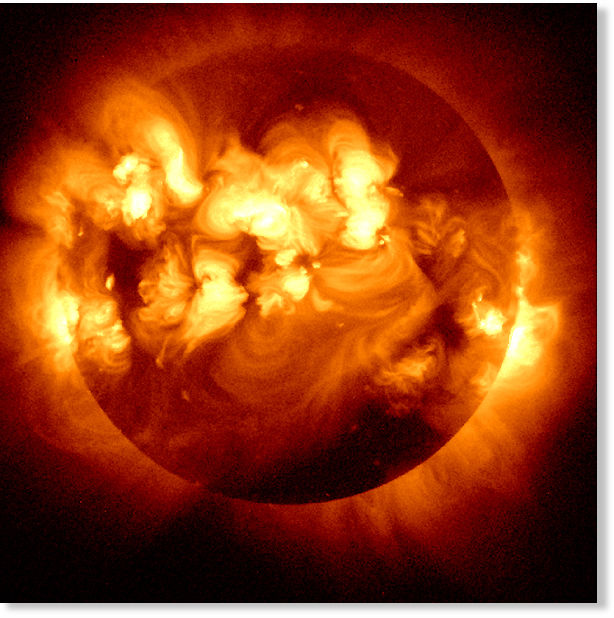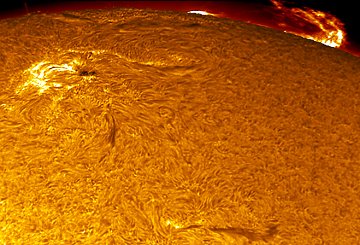
So, do we really need to worry about a huge solar storm burning out the electrical systems of half the world in 2013? Masochists that we are here at the Telegraph, we love to shoot down our own stories, and I was cracking my knuckles for this one. It’s got all the ingredients – white-coated authority, grave warnings of impending doom, exciting sciencey nuclear nemesis in space. NASA! Solar flares! Planes falling out of the sky! Etc.
But I read the piece, and spoke to the reporter, and – while always remembering that I am no more an astrophysicist than I am a black belt in tae kwon do – it sounded pretty solid. Dr Richard Fisher, the director of Nasa’s Heliophysics division, is very clear in the quotes, and our reporter, Andrew Hough, was very careful to check his facts with Dr Fisher before publishing. It sounds like a lot of serious people think that this is a real danger.
Apparently the concern is in 2013, the sun will reach a stage of its cycle when these large events are more likely. This might strike you as a bit strange, as you’ve probably heard (as have I) that the sun has been especially active for the last half-century or so and is expected to die down in the next couple of years – I spoke to Marcus Chown, the physicist and author of We Need to Talk about Kelvin, who said “Solar activity has been abnormally high for the past 50 years, but the extremely feeble start to the latest 11-year cycle suggests this activity is coming to an end and things are going to be quiet on the Sun for quite a few years.” Dr Ruth Bamford, a plasma physicist at the Rutherford-Appleton Laboratory, agrees: “The sun has been particularly quiet for the last few years in a protracted solar minimum. It has just woken up, as it were, and started its usual 11-year cycle a bit later than most.”
So what’s going on? Well, something similar has happened before. In 1859 a huge solar storm burned out telegraph wires across Europe and the United States. Dr Stuart Clark has written a book, The Sun Kings, about when that happened. He says that the “Carrington flare”, as it was known, “smothered two-thirds of the Earth’s skies in a blood-red aurora a night later, and crippled all of global navigation and global communication, such as it was at that time. Compasses span uselessly and the telegraph network went down as phantom electricity surged through the wire.”
The sun had indeed been running at a record high for the latter half of the 20th century, and has now died down to its lowest level for a century. But Dr Clark warns that “average levels of solar activity has fallen does not mean that the Sun is immune from large flares or even giant ones. Low average levels of activity may even promote the giant flares.
“Perhaps like earthquakes, when there are constant flares/tremors the energy is dissipated evenly over long periods of time. But in periods of quiet, that energy can build up and then suddenly be released in a giant event. This remains speculation, however.”
2013 is when the next peak in the sun’s cycle of activity is expected, and while we cannot predict individual flares, Dr Clark says that the largest flares are often shortly after the peak.
Of course, if a proper “Carrington event” happens again, it has the potential to be far more problematic now than in 1859 when electric communication was barely in its infancy. Dr Clark says “There is absolutely no reason to believe that we are heading for solar armageddon in 2013, but sooner or later we should expect there to be another Carrington event and that is what these scientists [at NASA] are trying to prevent. Legislation in the US has just passed Congress to help harden the grid against solar flares.”
So – it’s a real thing, and we should be concerned. But preventive measures can be taken – satellites can be sent offline during big flares, power grids and communication networks can be shielded against electromagnetic radiation and so on. As Dr Bamford says: “The extreme events like the 1859 Carrington Event are 1-in-100-year probabilities, about the same probability as a storm of the level of Katrina hitting New Orleans – and New Orleans did not build their defences to withstand the extreme-but-unlikely magnitude. 100 years isn’t that long.
“But the end of the world it is not. Maybe as disruptive as an ash cloud, but not as protracted I’m sure.” She gives examples of precautions, like a GPS backup system called eLoran, or active mini-magnetosphere shielding for astronauts and satellites that her team have designed.
Of course, if those precautions are taken, and actually work, and no damage is done, then everyone will cry that it was all a big fuss over nothing, like they always do. So the scientists can’t win, really. But that’s just how it is.
 2013 solar storm picture
2013 solar storm picture 2013 solar storm picture
2013 solar storm picture 2013 solar storm picture
2013 solar storm picture 2013 solar storm picture
2013 solar storm picture
No comments:
Post a Comment